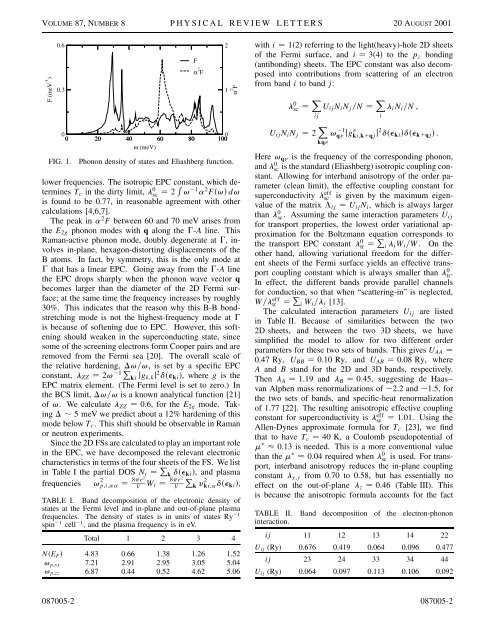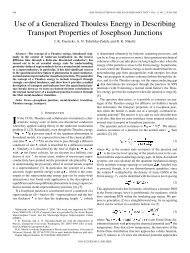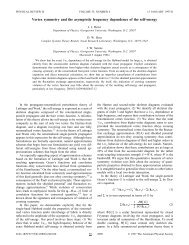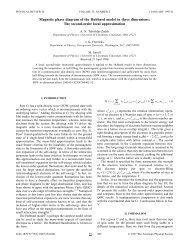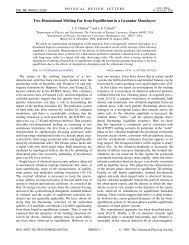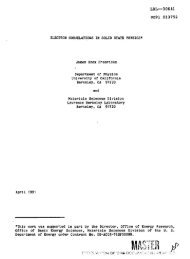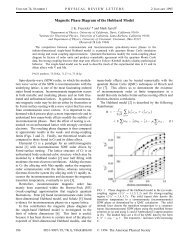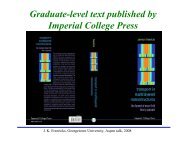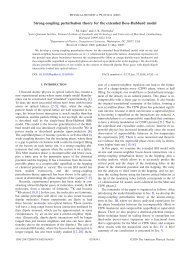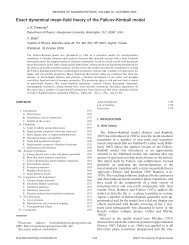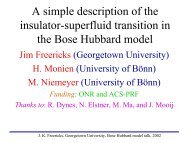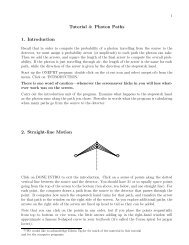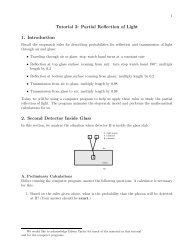Beyond Eliashberg superconductivity in MgB2 - Physics ...
Beyond Eliashberg superconductivity in MgB2 - Physics ...
Beyond Eliashberg superconductivity in MgB2 - Physics ...
You also want an ePaper? Increase the reach of your titles
YUMPU automatically turns print PDFs into web optimized ePapers that Google loves.
VOLUME 87, NUMBER 8 PHYSICAL REVIEW LETTERS 20AUGUST 2001<br />
F (meV -1 )<br />
0.6<br />
0.3<br />
F<br />
α 2 F<br />
2<br />
1<br />
α 2 F<br />
with i 12 referr<strong>in</strong>g to the light(heavy)-hole 2D sheets<br />
of the Fermi surface, and i 34 to the p z bond<strong>in</strong>g<br />
(antibond<strong>in</strong>g) sheets. The EPC constant was also decomposed<br />
<strong>in</strong>to contributions from scatter<strong>in</strong>g of an electron<br />
from band i to band j:<br />
l 0 sc X ij<br />
U ij N i N j N X i<br />
l i N i N ,<br />
0<br />
0<br />
0 20 40 60 80 100<br />
ω (meV)<br />
FIG. 1.<br />
Phonon density of states and <strong>Eliashberg</strong> function.<br />
lower frequencies. The isotropic EPC constant, which determ<strong>in</strong>es<br />
T c <strong>in</strong> the dirty limit, l 0 sc 2 R v 21 a 2 Fv dv<br />
is found to be 0.77, <strong>in</strong> reasonable agreement with other<br />
calculations [4,6,7].<br />
The peak <strong>in</strong> a 2 F between 60 and 70 meV arises from<br />
the E 2g phonon modes with q along the G-A l<strong>in</strong>e. This<br />
Raman-active phonon mode, doubly degenerate at G, <strong>in</strong>volves<br />
<strong>in</strong>-plane, hexagon-distort<strong>in</strong>g displacements of the<br />
B atoms. In fact, by symmetry, this is the only mode at<br />
G that has a l<strong>in</strong>ear EPC. Go<strong>in</strong>g away from the G-A l<strong>in</strong>e<br />
the EPC drops sharply when the phonon wave vector q<br />
becomes larger than the diameter of the 2D Fermi surface;<br />
at the same time the frequency <strong>in</strong>creases by roughly<br />
30%. This <strong>in</strong>dicates that the reason why this B-B bondstretch<strong>in</strong>g<br />
mode is not the highest-frequency mode at G<br />
is because of soften<strong>in</strong>g due to EPC. However, this soften<strong>in</strong>g<br />
should weaken <strong>in</strong> the superconduct<strong>in</strong>g state, s<strong>in</strong>ce<br />
some of the screen<strong>in</strong>g electrons form Cooper pairs and are<br />
removed from the Fermi sea [20]. The overall scale of<br />
the relative harden<strong>in</strong>g, Dvv, is set by a specific EPC<br />
constant, l ZZ 2v P 21 ki jg k,k j 2 de ki , where g is the<br />
EPC matrix element. (The Fermi level is set to zero.) In<br />
the BCS limit, Dvv is a known analytical function [21]<br />
of v. We calculate l ZZ 0.6, for the E 2g mode. Tak<strong>in</strong>g<br />
D 5 meV we predict about a 12% harden<strong>in</strong>g of this<br />
mode below T c . This shift should be observable <strong>in</strong> Raman<br />
or neutron experiments.<br />
S<strong>in</strong>ce the 2D FSs are calculated to play an important role<br />
<strong>in</strong> the EPC, we have decomposed the relevant electronic<br />
characteristics <strong>in</strong> terms of the four sheets of the FS. We list<br />
<strong>in</strong> Table I the partial DOS N i P k de ki , and plasma<br />
frequencies<br />
v 2 p,i,aa 8pe2<br />
V<br />
W i 8pe2<br />
V<br />
P<br />
k y 2 ki,ade ki ,<br />
TABLE I. Band decomposition of the electronic density of<br />
states at the Fermi level and <strong>in</strong>-plane and out-of-plane plasma<br />
frequencies. The density of states is <strong>in</strong> units of states Ry 21<br />
sp<strong>in</strong> 21 cell 21 , and the plasma frequency is <strong>in</strong> eV.<br />
Total 1 2 3 4<br />
NE F 4.83 0.66 1.38 1.26 1.52<br />
v p,xx 7.21 2.91 2.95 3.05 5.04<br />
v p,zz 6.87 0.44 0.52 4.62 5.06<br />
U ij N i N j 2 X vqn 21 jgki,k1qjj n 2 de ki de k1qj .<br />
kqn<br />
Here v qn is the frequency of the correspond<strong>in</strong>g phonon,<br />
and lsc 0 is the standard (<strong>Eliashberg</strong>) isotropic coupl<strong>in</strong>g constant.<br />
Allow<strong>in</strong>g for <strong>in</strong>terband anisotropy of the order parameter<br />
(clean limit), the effective coupl<strong>in</strong>g constant for<br />
<strong>superconductivity</strong> lsc<br />
eff is given by the maximum eigenvalue<br />
of the matrix L ij U ij N i , which is always larger<br />
than l 0 sc . Assum<strong>in</strong>g the same <strong>in</strong>teraction parameters U ij<br />
for transport properties, the lowest order variational approximation<br />
for the Boltzmann equation corresponds to<br />
the transport EPC constant ltr 0 P i l i W i W . On the<br />
other hand, allow<strong>in</strong>g variational freedom for the different<br />
sheets of the Fermi surface yields an effective transport<br />
coupl<strong>in</strong>g constant which is always smaller than ltr 0 .<br />
In effect, the different bands provide parallel channels<br />
for conduction, so that when “scatter<strong>in</strong>g-<strong>in</strong>” is neglected,<br />
Wltr eff P i W i l i [13].<br />
The calculated <strong>in</strong>teraction parameters U ij are listed<br />
<strong>in</strong> Table II. Because of similarities between the two<br />
2D sheets, and between the two 3D sheets, we have<br />
simplified the model to allow for two different order<br />
parameters for these two sets of bands. This gives U AA <br />
0.47 Ry, U BB 0.10 Ry, and U AB 0.08 Ry, where<br />
A and B stand for the 2D and 3D bands, respectively.<br />
Then l A 1.19 and l B 0.45, suggest<strong>in</strong>g de Haas–<br />
van Alphen mass renormalizations of 2.2 and 1.5, for<br />
the two sets of bands, and specific-heat renormalization<br />
of 1.77 [22]. The result<strong>in</strong>g anisotropic effective coupl<strong>in</strong>g<br />
constant for <strong>superconductivity</strong> is lsc<br />
eff 1.01. Us<strong>in</strong>g the<br />
Allen-Dynes approximate formula for T c [23], we f<strong>in</strong>d<br />
that to have T c 40 K, a Coulomb pseudopotential of<br />
m 0.13 is needed. This is a more conventional value<br />
than the m 0.04 required when lsc 0 is used. For transport,<br />
<strong>in</strong>terband anisotropy reduces the <strong>in</strong>-plane coupl<strong>in</strong>g<br />
constant l x,y from 0.70 to 0.58, but has essentially no<br />
effect on the out-of-plane l z 0.46 (Table III). This<br />
is because the anisotropic formula accounts for the fact<br />
TABLE II. Band decomposition of the electron-phonon<br />
<strong>in</strong>teraction.<br />
ij 11 12 13 14 22<br />
U ij (Ry) 0.676 0.419 0.064 0.096 0.477<br />
ij 23 24 33 34 44<br />
U ij (Ry) 0.064 0.097 0.113 0.106 0.092<br />
087005-2 087005-2


